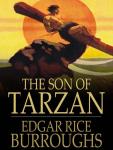
The Son of Tarzan
by Edgar Rice Burroughs
This book is a novel written by Edgar Rice Burroughs, the fourth in his series of books about the title character Tarzan.
Alexis Paulvitch, a henchman of Tarzan's now-deceased enemy, Nikolas Rokoff, survived his encounter with the ape-man in The Beasts of Tarzan and wants to even the score. He lures Jack, Tarzan's son, away from London and into his clutches, but the youngster escapes with the help of the ape named Akut.
The pair then flees into the deep African jungle where two decades earlier Tarzan himself had been raised. Jack Clayton, now on his own, becomes known as Korak the Killer and builds a reputation for himself in the jungle. Like his father before him, he finds his own place among the great apes, and also like his father, meets and rescues a beautiful young woman, Meriem, the daughter of a Captain in the French Foreign Legion, who was also a Prince (Prince de Cadrenet), named Armand Jacot.
Arguably, the book is as much about Meriem, wife of Korak, as it is about Tarzan's son.
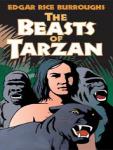
The Beasts of Tarzan
by Edgar Rice Burroughs
This book is a novel written by Edgar Rice Burroughs, the third in his series of books about the title character Tarzan.
Not long after Tarzan claims his hereditary title of Lord Greystoke and marries Jane, their infant son, Jack, is kidnapped in London by his old Russian enemies, Nikolas Rokoff and Alexis Paulvitch. Following an anonymous call about the whereabouts of Jack, Tarzan himself falls into Rokoff's trap and is imprisoned aboard a ship carrying Jack. Jane, fearing Tarzan was entering a trap, follows him and also finds herself in Rokoff's clutches aboard the ship. Rokoff sets sail to Africa, eventually exiling Tarzan on an island near the African coast and telling Tarzan that Jack will be left with a cannibal tribe and raised as one of their own.
Using his jungle skill and primal intelligence, Tarzan wins the help of Sheeta, the vicious panther, a tribe of great apes led by the intelligent Akut, and the native warrior Mugambi. With their aid, Tarzan reaches the mainland, kills Rokoff, and tracks down his wife and son. Paulvitch, the other villain, is presumed dead, but manages to escape into the jungle.
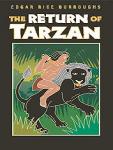
The Return of Tarzan
by Edgar Rice Burroughs
This book is a novel written by Edgar Rice Burroughs, the second in his series of books about the title character Tarzan.
The novel picks up where Tarzan of the Apes left off. The ape man, feeling rootless in the wake of his noble sacrifice of his prospects of wedding Jane Porter, leaves America for Europe to visit his friend Paul d'Arnot. On the ship he becomes embroiled in the affairs of Countess Olga de Coude, her husband, Count Raoul de Coude, and two shady characters attempting to prey on them, Nikolas Rokoff and his henchman Alexis Paulvitch. Rokoff, it turns out, is also the countess's brother. Tarzan thwarts the villains' scheme, making them his deadly enemies. Later, in France, Rokoff tries time and again to eliminate the ape man, finally engineering a duel between him and the count by making it appear that he is the countess's lover. Tarzan deliberately refuses to defend himself in the duel, even offering the count his own weapon after the latter fails to kill him with his own, a grand gesture that convinces his antagonist of his innocence. In return, Count Raoul finds him a job as a special agent in Algeria for the ministry of war. A sequence of adventures among the local Arabs ensues, including another brush with Rokoff. Afterwords, Tarzan sails for Cape Town and strikes up a shipboard acquaintance with Hazel Strong, a friend of Jane's. But Rokoff and Paulovitch are also aboard, and manage to ambush him and throw him overboard.
Miraculously, Tarzan manages to swim to shore, and finds himself in the coastal jungle where he was brought up by the apes. He soon rescues and befriends a native warrior, Busuli of the Waziri, and is adopted into the Waziri tribe. After defeating a raid on their village by ivory raiders he becomes their chief. The Waziri know of a lost city deep in the jungle, from which they have obtained their golden ornaments. Tarzan has them take him there, but is captured by its inhabitants, a race of beast-like men, and condemned to be sacrificed to their sun god. To his surprise, the priestess to perform the sacrifice is a beautiful woman, who speaks the ape language he learned as a child. She tells him she is La, high priestess of the lost city of Opar. When the ceremony is fortuitously interrupted, she hides him and promises to lead him to freedom. But the ape man escapes on his own, locates the treasure chamber, and manages to rejoin the Waziri.
Meanwhile, Hazel Strong has reached Cape Town, where she encounters Jane, and her father Professor Porter, together with Jane's fiancé, Tarzan's cousin William Cecil Clayton. They are all invited on a cruise up the west coast of Africa aboard the Lady Alice, the yacht of Lord Tennington, another friend. Rokoff, now using the alias of M. Thuran, ingratiates himself with the party and is also invited along. The Lady Alice breaks down and sinks, forcing the passengers and crew into the lifeboats. The one containing Jane, Clayton and "Thuran" is separated from the others and suffers terrible privations. Coincidentally, the boat finally makes shore in the same general area that Tarzan did. The three construct a rude shelter and eke out an existence of near starvation for some weeks until Jane and Clayton are surprised in the forest by a lion. Clayton loses Jane's respect by cowering in fear before the beast instead of defending her. But they are not attacked, and discover the lion dead, speared by an unknown hand. Their hidden savior is in fact Tarzan, who leaves without revealing himself.
Later Jane is kidnapped and taken to Opar by a party of beast-men pursuing Tarzan. The ape man tracks them and manages to save her from being sacrificed by La. La is crushed by Tarzan's rejection of her for Jane. Escaping Opar, Tarzan returns with Jane to the coast, happy in the discovery that she loves him and is free to marry him. They find Clayton, abandoned by "Thuran" and dying of a fever. In his last moments he atones to Jane by revealing Tarzan's true identity as Lord Greystoke, having previously discovered the truth but concealed it. Tarzan and Jane make their way up the coast to the former's boyhood cabin, where they encounter the remainder of the castaways of the Lady Alice, safe and sound after having been recovered by Tarzan's friend D'Arnot in another ship. "Thuran" is exposed as Rokoff and arrested. Tarzan weds Jane and Tennington weds Hazel in a double ceremony performed by Professor Porter, who had been ordained a minister in his youth. Then they all set sail for civilization, taking along the treasure Tarzan had found in Opar.

Tarzan of the Apes
by Edgar Rice Burroughs
Tarzan of the Apes is a novel written by Edgar Rice Burroughs, the first in a series of books about the title character Tarzan.
The novel tells the story of John Clayton, born in the western coastal jungles of equatorial Africa to a marooned couple from England, John and Alice (Rutherford) Clayton, Lord and Lady Greystoke. Adopted as an infant by the she-ape Kala after his parents died (his father is killed by the savage king ape Kerchak), Clayton is named "Tarzan" ("White Skin" in the ape language) and raised in ignorance of his human heritage.
Feeling alienated from his peers due to their physical differences, he discovers his true parents' cabin, where he first learns of others like himself in their books, with which he eventually teaches himself to read.
On his return from one visit to the cabin, he is attacked by a huge gorilla which he manages to kill with his father's knife, although he is terribly wounded in the struggle. As he grows up, Tarzan becomes a skilled hunter, gradually arousing the jealousy of Kerchak, the ape leader.
Later, an African tribe settles in the area, and Kala is killed by one of its hunters. Avenging himself on the killer, Tarzan begins an antagonistic relationship with the tribe, raiding its village for weapons and practicing cruel pranks on them. They, in turn, regard him as an evil spirit and attempt to placate him.
The twelve short stories Burroughs wrote later and collected as Jungle Tales of Tarzan occur in the period immediately following the arrival of the natives, the killing of Kala, and Tarzan's vengeance.
Finally Tarzan has amassed so much credit among the apes of the tribe that the envious Kerchak at last attacks him. In the ensuing battle Tarzan kills Kerchak and takes his place as "king" of the apes.
Subsequently, a new party of whites is marooned on the coast, including Jane Porter, the first white woman Tarzan has ever seen. Tarzan's cousin, William Cecil Clayton, unwitting usurper of the ape man's ancestral English estate, is also among the party. Tarzan spies on the newcomers, aids them, and saves Jane from the perils of the jungle. Absent when they are rescued, he is introduced further into the mysteries of civilization by French Naval Officer Paul D'Arnot, whom he saves from the natives. D'Arnot teaches Tarzan French and how to behave among white men, as well as serving as his guide to the nearest colonial outposts.
Ultimately, Tarzan travels to Jane's native Baltimore, Maryland only to find that she is now in the woods of Wisconsin. Tarzan finally meets Jane in Wisconsin where they renew their acquaintance and he learns the bitter news that she has become engaged to William Clayton. Meanwhile, clues from his parents' cabin have enabled D'Arnot to prove Tarzan's true identity. Instead of claiming his inheritance, Tarzan chooses to conceal his identity and renounce his heritage for the sake of Jane's happiness.
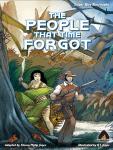
The People That Time Forgot
by Edgar Rice Burroughs
This book is an Edgar Rice Burroughs fantasy novel, the second of his Caspak trilogy.
The novel begins with the organization of an expedition to rescue Bowen J. Tyler, Lys La Rue, and the other castaways marooned on the large Antarctic island of Caprona, whose tropical interior, known to its inhabitants as Caspak, is home to prehistoric fauna of all eras. Tyler's recovered manuscript detailing their ordeal is delivered to his family, and the relief effort is put together by Tom Billings, secretary of the Tyler shipbuilding business. The expedition's ship, the Toreador, locates Caprona, and while the bulk of the crew attempts to scale the encircling cliffs Billings flies over them in an aircraft.
Billings' plane is attacked by flying reptiles and forced down in the interior of Caspak. He saves a native girl, Ajor, from a large cat and a group of ape-men, and undertakes to accompany her back to her people, the fully human Galus, while she educates him in the language and mysteries of the island. They travel north, encountering various creatures of the Mesozoic and Cenozoic eras, as well as additional primitive subhuman races. They pass through the lands of the Neanderthal Bo-lu (club men) and the more advanced Sto-lu (hatchet men), who are easily cowed by gunfire, but in the country of the Band-lu (spear men) he is taken captive, and despairs until rescued in turn by Ajor. They resume their journey, re-encountering and befriending Tomar, a Band-lu newly become Kro-lu (bow man). Tomar and his mate So-al are the first examples Billings has actually seen of Caspakian evolutionary metamorphosis in action.
After an interlude in which Ajor's back story is related the new friends separate. Billings and Ajor enter Kro-lu territory and save Chal-az, a Kro-lu warrior, from a group of Band-lu. Visiting the Kro-lu village as his guest, they are parted again when Billings is attacked through the machinations of the chief Du-seen, who has designs on Ajor. They escape individually, making for the Galu country. Du-seen goes after Ajor with some of his warriors.
Billings catches and tames an ancestral horse, with the aid of which he rescues Ajor from Du-seen. Pursued, they resign themselves to death, but are relieved by a force consisting of Bowen Tyler, Galu warriors, and the rescue crew from the Toreador, which had successfully scaled the cliffs and entered Caspak after Billings' ill-fated airplane flight. All are reunited in the Galu village, where Tyler and Lys La Rue have been formally married by the captain of the Toreador. Billings and Ajor also desire to wed, but Ajor may not leave Caspak due to her status as cos-ata-lo – she was born a fully evolved Galu rather than attaining that form through metamorphosis, and hence is treasured by her people. Billings elects to remain in Caspak to be with her.
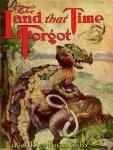
The Land That Time Forgot
by Edgar Rice Burroughs
This is an Edgar Rice Burroughs fantasy novel, the first of his Caspak trilogy. His working title for the story was "The Lost U-Boat." The sequence was first published in Blue Book Magazine as a three-part serial in the issues for September, October and November 1918. The complete trilogy was later combined for publication in book form under the title of the first part by A. C. McClurg in June 1924. Beginning with the Ace Books editions of the 1960s, the three segments have usually been issued as separate short novels. The first of these is treated in this article.
The novel is set in World War I and opens with a framing story in which a manuscript relating the main story is recovered from a thermos off the coast of Greenland. It purports to be the narrative of Bowen J. Tyler, an American passenger with his Airedale terrier Nobs on a ship sunk in the English Channel by a German U-boat, U-33, in 1916. He is rescued by a British tugboat with another survivor, Lys La Rue. The tug is also sunk, but its crew manages to capture the submarine when it surfaces. Unfortunately, all other British craft continue to regard the sub as an enemy, and they are unable to bring it to port. Sabotage to the navigation equipment sends the U-33 astray into the South Atlantic. The imprisoned German crew retakes the sub and begins a raiding cruise, only to be overcome again by the British. A saboteur continues to guide the sub off course, and by the time he is found out it is in Antarctic waters.
The U-33 is now low on fuel, with its provisions poisoned by the saboteur Benson. A large island ringed by cliffs is encountered, and identified as Caprona, a land mass first reported by the (fictitious) Italian explorer Caproni in 1721 whose location was subsequently lost. A freshwater current guides the sub to a stream issuing from a subterranean passage, which is entered on the hope of replenishing the water supply. The U-boat surfaces into a tropical river teeming with primitive creatures extinct elsewhere; attacked, it submerges again and travels upstream in search of a safe harbor. It enters a thermal inland sea, essentially a huge crater lake, whose heat sustains Caprona’s tropical climate. As the sub travels north along the island’s waterways the climate moderates and wildlife undergoes an apparent evolutionary progression.
On the shore of the lake the crew builds a palisaded base, dubbed Fort Dinosaur for the area’s prehistoric fauna. The British and Germans agree to work together under Tyler, with Bradley, the mate from the tug, as second in command and Von Schoenvorts, the original sub commander, in control of the Germans. The castaways are attacked by a horde of beast men and take prisoner Ahm, a Neanderthal. They learn that the native name for the island is Caspak. Oil is discovered, which they hope to refine into fuel for the U-33. As they set up operations, Bradley undertakes various explorations. During his absence Lys disappears and the Germans mutiny again, absconding with the submarine.
Tyler leaves the other survivors to seek and rescue Lys. A series of adventures ensues among various bands of near-human primitives, each representing a different stage of human advancement, as represented by their weaponry. Tyler rescues Lys from a group of Sto-lu (hatchet men), and later aids the escape of a woman of the Band-lu (spearmen) to the Kro-lu (bowmen). Lys is lost again, and chance discoveries of the graves of two men associated with Bradley’s expedition leaves Tyler in despair of that party’s fate. Unable to find his way back to Fort Dinosaur, he retreats to the barrier cliffs ringing Caspak in a vain hope of attracting rescue from some passing ship. Improbably reunited with Lys, he sets up house with her, completes the account of his adventures which he has been writing, and casts it out to sea in his thermos.

Wuthering Heights
by Emily Bronte
Wuthering Heights is a novel by Emily Brontë, written between October 1845 and June 1846, and published in 1847 under the pseudonym "Ellis Bell." It was her first and only published novel: she died aged 30 the following year. The decision to publish came after the success of her sister Charlotte's novel, Jane Eyre. After Emily's death, Charlotte edited the manuscript of Wuthering Heights, and arranged for the edited version to be published as a posthumous second edition in 1850.
Wuthering Heights is the eponymous farmhouse on the Yorkshire moors where the story unfolds. Its core theme is the enduring love between the heroine, Catherine Earnshaw, and her father's adopted son, Heathcliff and how it eventually destroys their lives and the lives of those around them.
Although Wuthering Heights became a classic of English literature, it received mixed reviews when first published, and was considered controversial because its depiction of mental and physical cruelty was so unusually stark. In the second half of the 19th century, Charlotte Brontë's Jane Eyre was considered the best of the Brontë sisters' works, but later critics argued that Wuthering Heights was superior.

Villette
by Charlotte Bronte
Villette is a novel by Charlotte Brontë, published in 1853.
Villette begins with its famously passive and secretive protagonist, Lucy Snowe, age 14, observing her godmother, Mrs. Bretton, Mrs. Bretton's son, Graham, and a young visitor, Paulina Home, known to everyone as "Polly." The child is a peculiar little thing and soon develops a deep devotion for the younger Graham, who showers her with attention until her stay is cut short when her father comes to take her away.
Lucy left the house soon after the child's departure, and after some initial hesitation, she was hired as a carer by Miss Marchmont, a rheumatic crippled woman. Soon she was accustomed to her new career and host, and started feeling content with the quiet lifestyle. However, in an evening with dramatic weather changes, Miss Marchmont magically regained all her energies and felt young again. She shared her sad love story of thirty years previously with Lucy, and concluded that she should try to treat Lucy better, be a better person since then and would get together with her dead lover through death. In the very next morning, Lucy found Miss Marchmont peacefully lifeless in bed.
In the ensuing years, an unspecified family tragedy forces Lucy into action, causing her to seek employment, and at age 23 she boards a ship for "Labassecour" (French for 'farmyard' and based on Belgium) despite not speaking a word of French on a hope that maybe she may find something in a new place. After arriving in the capital city of Villette, Lucy finds work as a teacher at Mme. Beck's boarding school for girls (which can be seen as a literary representation of the Hégers' Brussels pensionnat), and thrives despite Mme. Beck's constant surveillance of the students and staff.
Dr. John, a handsome English doctor, frequently visits the school because of his love for the coquette Ginevra. In one of Villette's famous plot twists, Dr. John is later revealed to be Graham Bretton, a fact that Lucy has known but deliberately concealed from the reader. After Dr. John discovers Ginevra's unworthiness, his brotherly instincts turn his attention to Lucy, and they become close friends which she values very highly despite her usual emotional reserve. We meet "Polly" again at this point (although her father has come into the title de Bassompierre which makes her now Paulina Home de Bassompierre) when Dr. Bretton saves her from being trodden upon at the theatre one night. They soon discover that they know each other and renew their friendship, which quickly blossoms into something more. The two fall in love and eventually marry, which Lucy has long seen coming, and she understands without sharing their facile happiness.
At the same time, Lucy has the first of several encounters with a shadowy nun in the attic who may be the ghost of a nun buried alive on the grounds for breaking her vows of chastity; in a highly symbolic scene, she finally finds the nun's habit in her bed and destroys it. She later discovers it to be the disguise of Ginevra's amour, de Hamal.
Lucy finds herself becoming closer to a colleague, the fiery schoolmaster M. Paul Emanuel; the two eventually fall in love. However, a group of conspiring antagonists, including Mme. Beck, the priest Père Silas, and the relatives of M. Paul's long-dead fiancée, struggle to keep the two apart, and finally succeed in forcing M. Paul's departure for the West Indies to oversee his plantation there. He nonetheless declares his love for Lucy before his departure, and arranges for her to live independently as the headmistress of her own day school or externat, which she later expands into a pensionnat. Villette's final pages are ambiguous; though Lucy says that she wants to leave the reader free to imagine a happy ending, she hints strongly that M. Paul's ship was destroyed by a storm on his return from the West Indies, killing him. She claims, for example, that "the three happiest years of [her] life" were those before M. Paul's return journey, which would suggest that he did indeed fall victim to the "destroying angel of tempest". Brontë described the ambiguity in the ending as a "little puzzle".
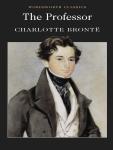
The Professor
by Charlotte Bronte
The Professor was the first novel by Charlotte Brontë. It was originally written before Jane Eyre and rejected by many publishing houses, but was eventually published posthumously in 1857 by approval of Arthur Bell Nicholls, who accepted the task of reviewing and editing of the novel.
The book is the story of a young man, William Crimsworth, and is a first-person narrative from his perspective. It describes his maturation, his loves and his eventual career as a professor at an all-girls school.
The story starts off with a letter William has sent to his friend Charles, detailing his refusal to his uncle's proposals to become a clergyman, as well as his first meeting with his rich brother Edward. Seeking work as a tradesman, William is offered the position of a clerk by Edward. However, Edward is jealous of William's education and intelligence and treats him terribly. By the actions of the sympathetic Mr. Hunsden, William is relieved of his position and gains a new job at an all-boys boarding school in Belgium.
The school is run by the friendly M. Pelet, who treats William kindly and politely. Soon, William's merits as a professor reach the ears of the headmistress of the neighboring girls school. Mlle. Reuter offers him a position at her school, which he accepts. Initially captivated by Mlle. Reuter, William begins to entertain ideas of falling in love with her, only to have them crushed when he overhears her and M. Pelet talk about their upcoming marriage.
Slightly heartbroken, he now treats Mlle. Reuter with a cold civility and begins to see the underlying nature of her character. Mlle. Reuter, however, continues to try to draw William back in, pretending to be benevolent and concerned. She goes so far as to plead him to teach one of her young teachers, Frances, who hopes to improve her skill in languages. William sees in this pupil promising intelligence and slowly begins to fall in love with her as he tutors her English.
Jealous of the attention Francis is receiving from William, Mlle. Reuter takes it upon herself to casually dismiss Frances from her school and hide her address from William. It is revealed that as she was trying to make herself amiable in William's eyes, Mlle. Reuter accidentally fell in love with him herself. Not wanting to cause a conflict with M. Pelet, Crimsworth leaves his establishment and moves out, in hopes of finding Frances.
Eventually bumping into his beloved pupil in a graveyard, the two reconcile. William gets a new position as a professor at a college, with an exceedingly high wage. The two eventually open a school together and have a child. After obtaining financial security, the family travels all around England and settle in the countryside next to Mr. Hunsden.

Jane Eyre
by Charlotte Bronte
Jane Eyre is a first-person narrative of the title character. The novel goes through five distinct stages: Jane's childhood at Gateshead, where she is emotionally and physically abused by her aunt and cousins; her education at Lowood School, where she acquires friends and role models but also suffers privations and oppression; her time as the governess of Thornfield Hall, where she falls in love with her Byronic employer, Edward Rochester; her time with the Rivers family, during which her earnest but cold clergyman cousin, St John Rivers, proposes to her; and the finale with her reunion with, and marriage to, her beloved Rochester. During these sections the novel provides perspectives on a number of important social issues and ideas, many of which are critical of the status quo (see the Themes section below). Literary critic Jerome Beaty notes that the close first person perspective leaves the reader "too uncritically accepting of her worldview" and often leads reading and conversation about the novel towards supporting Jane, regardless of how irregular her ideas or perspectives.

The Tenant of Wildfell Hall
by Anne Bronte
The Tenant of Wildfell Hall is the second and final novel by English author Anne Brontë, published in 1848 under the pseudonym Acton Bell. Probably the most shocking of the Brontës' novels, this novel had an instant phenomenal success but after Anne's death her sister Charlotte prevented its re-publication.
The novel is framed as a letter from Gilbert Markham to his friend and brother-in-law about the events leading to his meeting his wife.
A mysterious young widow arrives at Wildfell Hall, an Elizabethan mansion which has been empty for many years, with her young son and servant. She lives there under an assumed name, Helen Graham in strict seclusion, and very soon finds herself the victim of local slander. Refusing to believe anything scandalous about her, Gilbert Markham, a young farmer, discovers her dark secrets. In her diary Helen writes about her husband's physical and moral decline through alcohol and the world of debauchery and cruelty from which she has fled. This novel of marital betrayal is set within a moral framework tempered by Anne's optimistic belief in universal salvation.
May Sinclair, in 1913, said that the slamming of Helen's bedroom door against her husband reverberated throughout Victorian England. In escaping from her husband, she violates not only social conventions, but also English law.

Agnes Grey
by Anne Bronte
Agnes Grey is the debut novel of English author Anne Brontë, first published in December 1847, and republished in a second edition in 1850. The novel follows Agnes Grey, a governess, as she works in several bourgeois families. Scholarship and comments by Anne's sister Charlotte Brontë suggest the novel is largely based on Anne Brontë's own experiences as a governess for five years. Like her sister Charlotte's novel Jane Eyre, it addresses what the precarious position of governess entailed and how it affected a young woman.
Agnes Grey is the daughter of a minister, whose family comes to financial ruin. Desperate to earn money to care for herself, she takes one of the few jobs allowed to respectable women in the early Victorian era, as a governess to the children of the wealthy. In working with two different families, the Bloomfields and the Murrays, she comes to learn about the troubles that face a young woman who must try to rein in unruly, spoiled children for a living, and about the ability of wealth and status to destroy social values. After her father's death Agnes opens a small school with her mother and finds happiness with a man who loves her for herself. By the end of the novel they have three children, Edward, Agnes and Mary.
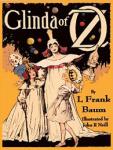
Glinda Of Oz
by L. Frank Baum
In Which Are Related the Exciting Experiences of Princess Ozma of Oz, and Dorothy, in Their Hazardous Journey to the Home of the Flatheads, and to the Magic Isle of the Skeezers, and How They Were Rescued from Dire Peril by the Sorcery of Glinda the Good is the fourteenth Land of Oz book written by children's author L. Frank Baum, published on July 10, 1920. It is the last book of the original Oz series, which was later continued by other authors. Like most of the Oz books, the plot features a journey through some of the remoter regions of Oz; though in this case the pattern is doubled: Dorothy and Ozma travel to stop a war between the Flatheads and Skeezers; then Glinda and a cohort of Dorothy's friends set out to rescue them.
Princess Ozma and Dorothy travel to an obscure corner of the Land of Oz, in order to prevent a war between two local powers, the Skeezers and the Flatheads. The leaders of the two tribes prove obstinate. Unable to prevent the war, Dorothy and Ozma find themselves imprisoned on the Skeezers' glass-covered island, which has been magically submerged to the bottom of its lake. Their situation worsens when the warlike queen Coo-ee-oh, who is holding them captive and who alone knows how to raise the island back to the surface of the lake, loses her battle and gets transformed into a swan, forgetting all her magic in the process. Ozma and Dorothy summon Glinda, who, with help from several magicians and magical assistants, must find a way to raise the island and liberate its trapped inhabitants.
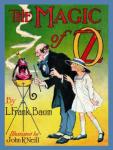
The Magic of Oz
by L. Frank Baum
A Faithful Record of the Remarkable Adventures of Dorothy and Trot and the Wizard of Oz, Together with the Cowardly Lion, the Hungry Tiger and Cap'n Bill, in Their Successful Search for a Magical and Beautiful Birthday Present for Princess Ozma of Oz is the thirteenth Land of Oz book written by L. Frank Baum. Published on June 7, 1919, one month after the author's death, The Magic of Oz relates the unsuccessful attempt of the Munchkin boy Kiki Aru and former Nome King Ruggedo to conquer Oz.
At the top of Mount Munch, lives a group of people known as the Hyups. One of their numbers, a Munchkin named Bini Aru, discovered a method of transforming people and objects by merely saying the word "Pyrzqxgl". After Princess Ozma decreed that no one could practice magic in Oz except for Glinda the Good Witch and the Wizard of Oz, Bini wrote down the directions for pronouncing "Pyrzqxgl" and hid them in his magical laboratory.
When Bini and his wife are at a fair one day, their son Kiki Aru, who thirsts for adventure, finds the directions and afterwards transforms himself into a hawk and visits various countries outside the land of Oz. When he alights in the land of Ev, Kiki Aru learns that he needs money to pay for a night's lodging (versus Oz, where money is not used at all) and changes himself into a magpie to steal a gold piece from an old man. A sparrow confronts the then-human Kiki Aru with knowledge of the theft, and Kiki says that he did not know what it was like to be wicked before, he is glad that he is now. This conversation is overheard by Ruggedo, the Nome who was exiled to the Earth's surface in Tik-Tok of Oz, and he sees through Kiki Aru's power a chance to get revenge on the people of Oz.
Kiki changes himself and Ruggedo into birds and they fly over the Deadly Desert into the Land of Oz. They enter Oz as animals to escape detection by Glinda and to recruit an army of conquest from the country's wild animal population. When they first appear in the Forest of Gugu in the Gillikin Country, Kiki changes himself and Ruggedo into Li-Mon-Eags (fictional creatures with the heads of lions, the bodies of monkeys, and the wings of eagles as well as having the tails of donkeys) and lies that they've seen the people of the Emerald City plan to enslave the animal inhabitants of the Forest. Ruggedo claims that they the Li-Mon-Eags will transform the animals into humans and march on the Emerald City and transform its inhabitants into animals, driving them into the forest. Ruggedo proves their power (for Kiki's the only one who knows "Pyrzqxgl") by having Kiki transform one of the leopard king Gugu's advisors, Loo the unicorn, into a man and back again. Gugu offers to meet with the leaders of the other animal tribes to decide on this matter of invasion.
Dorothy and the Wizard arrive with the Cowardly Lion and the Hungry Tiger in the Forest of Gugu during this council of war with a request for monkeys to train in time for Ozma's upcoming birthday party. Ruggedo recognizes his old enemies and inspires Kiki to begin transforming people and animals left and right — including Ruggedo, whom Kiki turns against by transforming him into a goose, a transformation that the Nomes most fears because as a goose he might lay an egg.
The Wizard, whom Kiki transformed into a fox, follows the Li-Mon-Eag with his magic bag, the transformed Kiki, deep into the forest where he begins transforming monkeys into giant human soldiers. However, Kiki makes them so big that they cannot move through the trees. The Wizard, however, heard how to correctly pronounce "Pyrzqxgl" and first stops Kiki and Ruggedo by transforming them into a walnut and a hickory nut. Then the Wizard resumes his rightful form and changes Dorothy, the Cowardly Lion, the Hungry Tiger, and Gugu back to their forms, and he agrees to change the soldiers back into monkeys. The Wizard recruits several of the grateful monkeys and shrinks them down to bring back to the Emerald City and train.
On arriving there, Dorothy and the Wizard are dispatched to a magic island where Cap'n Bill and Trot went to get a magic flower for Ozma's birthday. However, the island itself causes anything living that touches it to take root there, and that is how the sailor and his friend are found when Dorothy and the Wizard arrive. The Wizard uses "Pyrzqxgl" to change Cap'n Bill and Trot into honeybees which narrowly avoid being eaten by the Cowardly Lion and the Hungry Tiger. When they are human again, Cap'n Bill retrieves the flower by strapping a wood plank onto his good leg, walks with that and his wooden leg onto the island, and retrieves the flower.
Back at the Emerald City, Ozma and her friends celebrate her birthday (though without quite the pomp and fanfare from The Road to Oz) and then decide how to deal with the evil magicians transformed into nuts. The Wizard uses "Pyrzqxgl" to change them back to Kiki Aru and Ruggedo and make them thirsty enough to drink the Water of Oblivion, which will make them forget all that they have ever known. The now-blank slate Kiki Aru and Ruggedo will live in the Emerald City and learn to be good and kind.
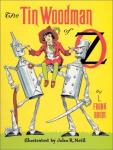
The Tin Woodman Of Oz
by L. Frank Baum
A Faithful Story of the Astonishing Adventure Undertaken by the Tin Woodman, Assisted by Woot the Wanderer, the Scarecrow of Oz, and Polychrome, the Rainbow's Daughter is the twelfth Land of Oz book written by L. Frank Baum and was originally published on May 13, 1918. The Tin Woodman is unexpectedly reunited with his Munchkin sweetheart Nimmie Amee from the days when he was flesh and blood. This was a back-story from The Wonderful Wizard of Oz.
The Tin Woodman and the Wizard of Oz are regaling each other with tales at the Woodman's palace in the Winkie Country when a Gillikin boy named Woot wanders in. After he is fed and rested, Woot asks the Woodman how he came made of tin.
He relates how the Wicked Witch of the East enchanted his axe and caused him to chop his body parts off limb by limb, because he was in love with her ward, Nimmie Amee. Each chopped limb was replaced by the tinsmith Ku-Klip with a counterpart made of tin. (Since Oz is a fairyland, no one can die, even when the parts of their body are separated from each other.) Without a heart, the Tin Woodman feels he can no longer love Nimmie Amee and he leaves her. Dorothy and the Scarecrow find him after he has rusted in the forest (an event related in The Wonderful Wizard of Oz) and go with him to the Emerald City where the Wizard gives him a heart. Woot suggests that the heart may have made him kind, but it did not make him loving. or he would have returned to Nimmie Amee. This shames the Tin Woodman and inspires him to journey to the Munchkin Country and find her.
The Tin Woodman, the Scarecrow, and Woot journey into the Gillikin Country and encounter the inflatable Loons of Loonville, whom they escape by popping several of them. They descend into Yoop Valley, where the giantess Mrs. Yoop dwells, who transforms the travelers into animals for her amusement, just as she has already done to Polychrome, the Rainbow's Daughter. Woot steals a magic apron that performs any task that its wearer wishes, enabling the four to escape. Woot, as a green monkey, narrowly avoids becoming a jaguar's meal by descending further into a den of subterranean dragons. After escaping that ordeal, Woot, the Tin Woodman as a tin owl, the Scarecrow as a straw-stuffed bear, and Polychrome as a canary turn south into the Munchkin Country and, with Polychrome's magic, reverse a spell cast on Tommy Kwikstep, a messenger boy who thoughtlessly wished himself twenty legs.
They arrive at the farm of Jinjur, who first attacks what she thinks are ravening wild beasts (an act in itself strange in Oz, where birds and beasts talk and think) and then renews her acquaintance with them and sends to the Emerald City for help. Dorothy and Ozma arrive and Ozma easily restores the Scarecrow and the Tin Woodman to their rightful forms. Polychrome takes several steps to restore to her true form. However, Ozma discovers that the Green Monkey into which Woot is transformed has to be someone's form; it cannot be destroyed. Polychrome suggests as a punishment for wickedness that Mrs. Yoop the giantess be made into the Green Monkey, and Ozma thus succeeds in restoring Woot to his proper form.
The Tin Woodman, the Scarecrow, Woot, and Polychrome resume their quest and come upon the spot where the Tin Woodman had rusted and find another tin man there. After they oil his joints, he identifies himself as Captain Fy-ter, a soldier who courted Nimmie Amee after the Woodman had left her. The Wicked Witch of the East had made Fy-ter's sword do what the Woodman's axe had done—cut off his limbs, which Ku-Klip replaced with tin limbs. He does not have a heart either, but this does not bother him. However, he can rust, which he does one day during a rainstorm. Both woodmen now seek the heart of Nimmie Amee, agreeing to let her choose between them.
The five come to the dwelling of the tinsmith Ku-Klip where the Tin Woodman talks to himself—that is, to the head of the man (Nick Chopper) he once was. The Tin Woodman and the Tin Soldier also find a barrel of assorted body parts that once belonged to each of them, but some, like Captain Fy-ter's head, are conspicuously missing. Ku-Klip reveals that he used Fy-ter's head and many body parts from each of them (which never decayed) to create his assistant Chopfyt. Chopfyt complained about missing an arm until Ku-Klip made him a tin one, and he departed for the east.
The companions leave Ku-Klip and continue east themselves to find Nimmie Amee and find themselves crossing the Invisible Country, where a massive Hip-po-gy-raf helps them across in return for the Scarecrow's straw. Reluctantly, he gives it and consents to being stuffed with available hay, which makes his movements awkward. They rest for the night at the house of Professor and Mrs. Swynne, pigs whose nine children live in the Emerald City under the care of the Wizard.
They leave the Swynnes and arrive at the foot of Mount Munch on the eastern border of the Munchkin Country. At its summit is a cottage where a rabbit tells them Nimmie Amee now lives happily. However, a wall of hardened air that they cannot penetrate surrounds the cottage. Polychrome with her magic shrinks them to fit into the rabbit's burrow and travel under the wall. Restoring them to normal size, the Tin Woodman and Tin Soldier knock and are admitted by Nimmie Amee, who is now married to Chopfyt. She refuses to leave her domestic life, even to become Empress of the Winkies (which she would become as the Tin Woodman's wife), saying "All I ask is to be left alone and not be disturbed by visitors."
They leave the cottage during a rainstorm, are reduced in size and restored again, and Polychrome on a rainbow leaves the two woodmen and the Scarecrow to be cared for by Woot, who does not rust or get soggy or moldy. The four return to the Emerald City and relate their adventures. Woot is allowed free rein to roam where he pleases, Captain Fy-ter is dispatched by Ozma to guard duty in the Gillikin Country, and the Tin Woodman and Scarecrow return to his palace in the Winkie Country where the story began.